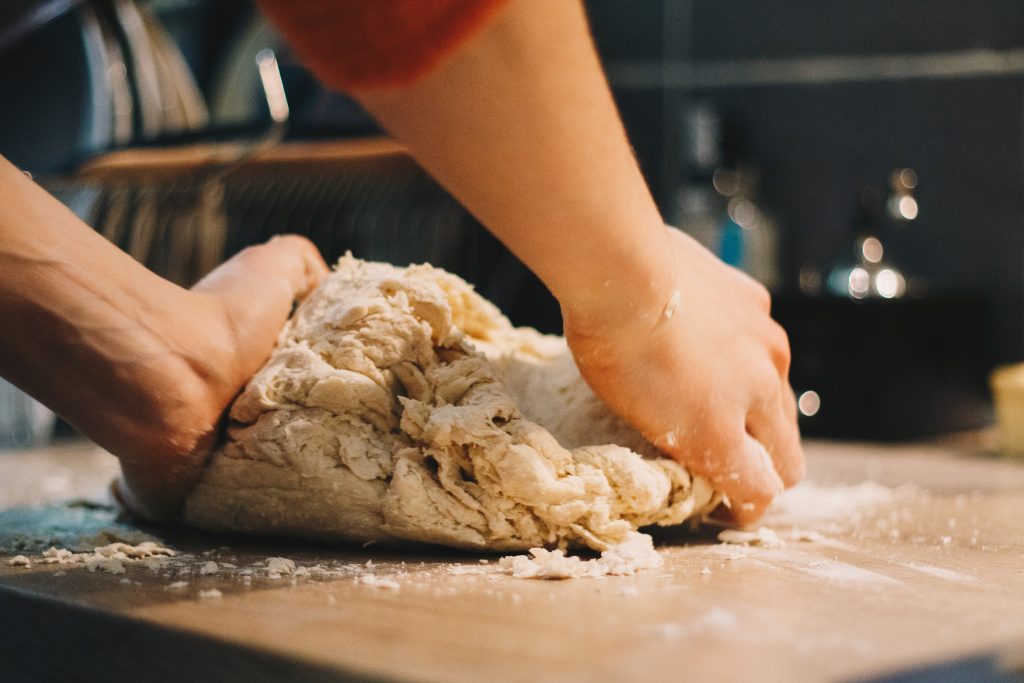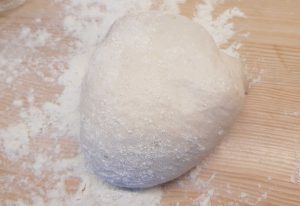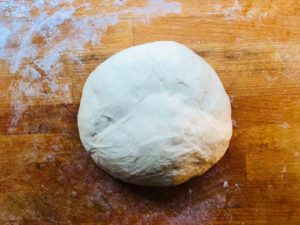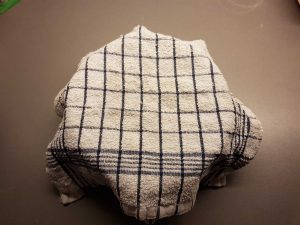Are you frustrated that your pizza dough always tears when you’re stretching it? I feel you, we’ve all been there. It takes a lot of time and practice to fully master pizza baking, but luckily you can fix your taring pizza dough with the proper recipe, good ingredients, and the right techniques.
The main reason pizza dough tears when you’re stretching it is the lack of gluten development and the use of the improper stretching technique.
Why pizza dough tear when stretching it
Every great pizza starts with good a pizza dough recipe. That said, the two main reasons your dough tears, when you stretch it, are the lack of gluten development and improper stretching technique.
Lack of gluten development
Gluten is one of those topics I always have to come back to when I’m talking about pizza dough. It’s the single most important factor in a great, stretchy dough that doesn’t tear.
What is gluten and why is it important to prevent tearing?
Gluten is a type of protein found in wheat flour. The reason it’s so important in pizza baking is that it keeps the dough stuck together in one, large mass. If your dough doesn’t have any gluten, it will simply fall apart. Gluten will give the dough structure and make it elastic and stretchy. The reason is that gluten forms a strong network of gluten strands.
The magic happens when you first hydrate the gluten, followed by kneading the dough. The gluten will start to grow a strong network of gluten strands, that will give the dough structure. The more you knead the dough, the stronger this network will be, and the better it will keep the structure of the dough.
Gluten is essential to prevent tearing. This network almost works like a rope, that’s much stronger than the individual fibers it’s made of. So when this network develops and gets stronger the dough is much less likely to tear. That’s why gluten plays an extremely important role in pizza dough baking. Without it, you’re not able to make a stretchable dough.
To get proper gluten development you need to use the right type of flour and use the right dough hydration. You also need to knead the dough to develop the gluten and give it time to relax before you stretch your pizzas. I will go through all these steps in detail, but first, let’s look at the other main reasons for tearing.
Check out this article if you want to know more about gluten and how it affects your pizza dough.
Improper stretching technique
The second reason your pizza dough tears when you’re stretching it is that you don’t use the right stretching technique. The dough should be handled gently and needs even stretching to prevent tearing.
Different style of pizza also requires different stretching methods. You can read more about how to pick the right method here: The best way to stretch pizza dough.
How to fix tearing pizza dough if the damage already happened
If your dough has already torn, the easiest way to fix it is by patching it by folding the dough over the hole, and gently pressing it to make an even patch. But you have to be careful not to tear the dough any further or to make the area around the hole too thin when you’re pathing it.
How to prevent pizza dough from tearing when stretching
To prevent tearing the most important thing is enough gluten development. That means you need medium-high protein flour, proper hydration of the flour, and sufficient kneading of the dough.
- Use high-quality flour with the right protein level
- Use the right hydration level
- Kneading the dough long enough to develop gluten
- Let the dough relax to get more stretchy
- Make sure the dough is at room temperature
- Use the Proper Stretching Technique
- Make sure the dough is at room temperature
Let’s go over all the individual parts of making a stretchy dough that will not tear on you.
Use high-quality flour
Flour is the most important ingredient in great pizza dough and is what ultimately dictates gluten development. You should therefore pick your flour carefully.
Pizza flour
You see the word pizza flour thrown around, but what is actually pizza flour? Pizza flour most commonly refers to Italian Tipo 0 or Tipo 00 flour. These are Italian-milled wheat flour with a gluten content of around 10-12%. This is what’s stated by The True Neapolitan Pizza Association (AVPN) to be the right type of flour and the optimal gluten content for Neapolitan pizza.
Tipo 0 and Tipo 00 are categories on the Italian flour scale. These may vary a lot in quality and gluten, it’s therefore important to use a high-quality flour, such as Caputo Pizzeria (affiliate link). This is one of my personal favorites.
Caputo Pizzeria is a fairly strong flour that can easily handle a 24-hour rise, and it’s therefore perfect for Neapolitan-style pizza. You can read my full review here if you want to know what’s so special about this flour.
Hydration – add enough water to your dough
The general rule is the more water your dough contains, the stretchier it will be the less likely it is to tear.
What is pizza dough hydration?
Dough hydration is the amount of water compared to the amount of flour in your dough. When you increase hydration (add more water to the dough), the dough will get softer and more extensible. This added softness will also make the dough easier to stretch.
What is the ideal hydration to prevent your pizza dough from tearing when stretching it?
The perfect hydration depends on your flour but a good starting point is 60-65% hydration. This will make a nice elastic dough, that won’t tear when you shape your pizza.
Hydration is a rather complicated topic, and there are so many factors that affect the consistency of the dough, so 65-70% is just a starting point, you should absolutely experiment to find the optimal hydration level for your favorite flour and baking environment. I’ve written an in-depth article on the topic if you want to know more.
Kneading the dough long enough to develop gluten
To develop a strong gluten network, that keeps your dough from tearing, you need to knead the dough long enough. The number one mistake people who are struggling with their dough tearing make is to not knead the dough long enough to develop gluten.

Hydrate the gluten
You also need to let the gluten hydrate before you start kneading. This is important for the gluten to develop properly. This will also soften the strands, making it easier to knead the dough.
You can introduce autolyse to your baking to fully hydrate the gluten before you start kneading.
All you need to do is combining the ingredients and leave the dough to hydrate for 20-30 minutes before kneading. This short rest gives the flour enough time to hydrate. During this time, the gluten will start to develop and the amylase enzymes will start turning starch into sugars, giving the yeast a headstart. This will make a nice, extensible, and stretchy dough.
Kneading
There are many ways to knead pizza dough, but the most important factor is time. I see people kneading their dough for too short all the time, and this will cause the underdevelopment of gluten. You should knead the dough for at least 15 to 20 minutes by hand. If you’re using a stand mixer, I recommend running it at 5-minute intervals and checking the gluten development.
How to tell if the gluten has developed enough
The two most common ways to check if the dough gluten has developed enough are The Poke Test and The Windowpane Test.
The Poke Test
The way to perform The Poke Test is simply to poke the dough with your index finger and see if it springs back. If it does, this means that gluten has developed enough, and is strong enough to keep the shape of the dough. Read more about The Poke Test here
The Windowpane Test
The other way to check if the gluten has developed enough is The Windowpane Test. Take a small piece of dough, and stretch it out as thin as possible without making a hole in the dough. If the gluten has developed enough, you will be able to stretch it so thin that you can see light going through the dough. This is an indication the gluten is strong enough. You can read more about how to properly perform The Windowpane Test here.
What happens if you knead your dough too much?
If you overwork your dough, the gluten will get very strong and tense, making it hard to stretch the dough. When you bake your pizza the crust will also get hard and dense, and the interior will get dry.
Over-kneading by hand is not really an issue because it’s nearly impossible to do.
If you’re using a stand mixer, on the other hand, you need to keep an eye on the dough. So use The Windowpane Test, from the previous section, every 5 minutes or so, to make sure you don’t overdevelop the gluten. When your dough passes the test, stop the stand mixer immediately.
Gluten will weaken over time
If you leave the dough for too long, the gluten strands will start to weaken. This can take anywhere from a few hours to a few days, depending on the strength of your flour. Once again I want to emphasize the importance of high-quality pizza flour. When gluten starts to weaken it will tear easily.
Let the dough relax to get more stretchy
When you knead the dough the gluten strands tighten up. You should therefore let the dough rest for at least 30 minutes before you start stretching out the dough. When you give the gluten time to relax, it will soften, making the dough more pliable and easier to work with.
Proofing is an important part of the baking process, and it also gives your gluten time to relax. It’s therefore important that if you make dough balls after bulk fermenting your dough, you also give them time before starting to shape your pizzas.
Make sure the dough is at room temperature
If you’re cold-fermenting your dough in the fridge, or proof it in another low-temperature environment, it’s you should let it come to room temperature before you start stretching out your pizzas. Gluten will also tighten up, and get harder when it’s cold. I, therefore, recommend letting the dough rest at room temperature for at least 2-3 hours prior to stretching out your pizzas.
Remove anything that can tear your dough
Any pointy objects can tear the dough when you’re stretching it, you should therefore have a clean and smooth working surface, and remove any accessories from your hands before starting to work the dough.
Have a clean, smooth working surface
If your working surface has any irregularities, sharp edges, or anything like that, this can contribute to tearing. You should therefore make sure you have a smooth, clean working surface when you work with the dough.
Remove any accessories from your hand
It’s also a good idea to remove accessories, such as rings, watches, etc. before you start working the dough. In addition to potentially introducing bacteria to the dough, they can also tear it.
Use the Proper Stretching Technique
Mastering stretching is challenging and can take thousands of pizzas but it will come with practice, here’s an easy introduction. But it’s an important skill to prevent that pizza dough from tearing when you’re stretching it.
Stretching and shaping your pizzas consist of two steps. shape and flatten the dough and stretch it into a thin disc. (Keep in mind that if you haven’t made a proper pizza dough yet, with the right hydration and gluten development, this is going to be very challenging…)
Shape and flatten the dough
Start by covering the dough with flour, to prevent it from sticking to the working surface. Then, press it flat in the middle using the pad of your fingers. Start in the center of the dough and work your way out to the edge. This is pressing the gas from the middle to the edge of the pizza. It’s also important to leave around an inch (2-2.5cm) of edge. This will puff up in the oven, creating a nice, raised cornicione.
Stretching the dough
Then place the palm of your hands flat, inside the edge, and grab gently under the opposite side of the dough using your fingers pads. Carefully stretch the dough outwards, away from the flat hand. Fold the dough over onto your forearm, and flip it back to your working surface. It should turn around 1/3 to 1/4 of a rotation. That means that when you have performed this 3 to 4 times, the dough has rotated one whole rotation. You don’t want to stretch the dough too much, and should therefore aim to increase the diameter of the dough around 10% each rotation.
Finish by shaking off as much access flour as possible. Flour can burn and create smoke and unpleasant flavors if you bake the pizza in a hot oven.
Proper stretching is easier illustrated visually, I have therefore included this video from Jacob Burton on how to stretch pizza dough:
Prevent tearing when you transfer the pizza into the oven
One last thing to be wary about is that your pizza dough can also easily tear when you attempt to move it.
I bake most of my pizzas on a pizza steel in my home oven, to get a proper Neapolitan-style pizza. The challenge is then to transfer the pizza from the working surface to the hot steel. The easiest way to do this is by using a non-stick pizza peel.
Pizza can rip when you move it onto the
Conclusion
The secret to preventing your pizza dough from tearing when stretching it is in the dough, ingredients, and techniques.
It’s virtually impossible to make a pliable, stretchy dough without the right gluten development. And this depends a lot on your flour. With bad flour, either with too much or too little gluten, you’ll not be able to get the right gluten development. Another important factor in the gluten equation is hydration, and of course, kneading. Kneading often takes longer than most people think, but just give it the time it needs.
Great food often requires time!
When you’ve made the perfect dough, stretching and shaping the pizza should be fairly easy, without tearing the dough. The gluten development will make the dough stretchy and nice. Fully mastering the technique will require time and practice, but you should be able to get a decent pizza dough in no time!
Related
- Is Your Pizza Dough Too Dry? Here is How to fix it! - June 10, 2024
- The Ultimate Guide to the Pizza Dough Windowpane Test - June 8, 2024
- The Ultimate Guide to Autolyse Pizza Dough - June 7, 2024




